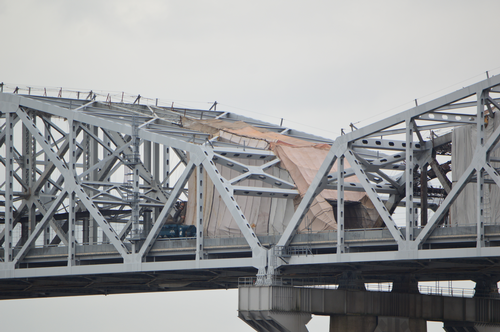THURSDAY, MARCH 16, 2017
Containing blasting work on a bridge is hard enough; containing blasting work to the middle of a bridge is truly a challenge. That's what Intech Contracting learned when, in 2016, the company was awarded a contract to clean and recoat only a portion of Louisiana's Huey P. Long Bridge: the portion that's surrounded on both sides by six lanes of traffic.
The Huey P. Long, in Jefferson Parish, just west of New Orleans, is a cantilevered through steel truss bridge over the Mississippi River, designed by Ralph Modejeski and built in 1935. It carries a two-track railroad line, with three lanes of traffic (from U.S. Route 90) situated on either side of the rail bridge.
The highway lanes were expanded and recoated as part of an earlier contract, completed in 2013, but at the time, the state didn't have sufficient funds to also recoat the railroad portion of the bridge, according to the Lousiana Department of Transportation & Development.

 |
| Images courtesy Lousiana DOTD |
|
Intech Contracting is currently recoating just the center, railroad part of the Huey P. Long Bridge, while vehicular and rail traffic continue. |
So when Intech was awarded the job by DOTD last year, it posed some interesting challenges for the contractor. Work on the project commenced last fall and is ongoing; Intech project manager Brad Wilder answered PaintSquare News' questions about how to go about containing a blasting job while traffic continues to flow on both sides of the work.
PaintSquare News: How did containment of lead paint and other debris differ on this project as opposed to other, more conventional bridge projects?
Wilder: The bridge itself is unusual in that it carries railroad in the center of the through truss with highway lanes to either side. Since we are only painting the railroad portion, the containment side walls must be pieced together to work around the connections between the railroad and highway sections of the truss. This means more, smaller tarps and many more bulkheads to seal off the connections.
The lower chords and floor system of the railroad section were also previously painted, so they did not need to be contained. So, to prevent any impact to ship traffic on the Mississippi River, none of our containment goes below low steel on the bridge. This creates similar issues of smaller sections of containment floor and numerous additional sealing bulkheads.
All this is done while maintaining strict horizontal and vertical clearances for railroad traffic. The railroads are operating as normal through the project.
What makes proper containment important on a job like this?
As with any similar project, containment is important to protect the environment and the public from potentially hazardous materials during removal of the existing coatings.
 |
|
"The bridge itself is unusual in that it carries railroad in the center of the through truss with highway lanes to either side," explains Intech Contracting's Brad Wilder. |
How does working over water change your approach to containment, as opposed a project that's over land?
When over land, we can oten use the ground itself to support the containment floor. Over water, everything must be attached to the structure while still leaving us room to do our work. Lack of access from below also changes the logistics of installing and moving containment materials.
How has vehicular traffic been affected by the repainting of the railroad section of the bridge? Were lane closures needed because of the complexity of the containment project?
There are three highway lanes crossing the bridge in each direction. One of these lanes in each side is closed for the duration of the project. This has made the rush hour commute over the bridge a little more challenging, but the public and our crews have both done a good job of adapting. Louisiana DOTD has made some helpful adjustments to the traffic control setup and we have seen an improvement in traffic flow since the early weeks of the project.
How big a portion of the railroad bridge is contained at any given time during the project?
About 10-15 percent, over multiple containments.
Would it have been considerably easier from a containment standpoint if this portion of the repainting job had been included in the earlier rehabilitation/expansion of the vehicular lanes?
There are tradeoffs either way. Containing the highway and railroad trusses simultaneously could have eliminated the need for many of the additional bulkheads. However, it would also make for a wider containment cross-section and likely would have required containment installation over live traffic lanes. In short, there is no easy way to paint a bridge this large and this complicated.
Tagged categories: Blasting; Bridges; Containment; Contractors; Program/Project Management; Project Management; Surface preparation